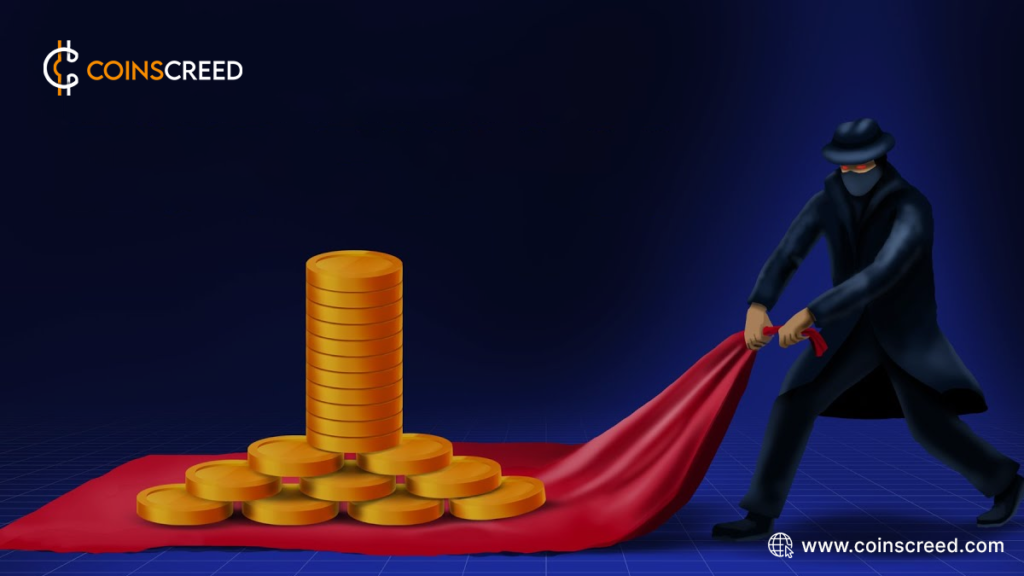DeFi’s financial revolution has brought many benefits but has also created an environment where scams like the rug pull can thrive.

Without understanding how these scams work, unsuspecting victims can be left devastated. This article provides essential guidance on recognizing and avoiding rug pulls, empowering you to navigate the DeFi landscape with confidence.
What is a Rug Pull?
A rug pull is a type of exit scam where developers of a DeFi project abandon it suddenly and take off with investors’ funds. This scam typically happens in the context of liquidity pools, where users deposit their tokens into a pool to facilitate trading. When a rug pull occurs, the developers drain the liquidity pool, leaving investors with worthless tokens.
How Rug Pulls Work
Here’s how rug pulls work:
Creation of a DeFi Project
Scammers often create a new DeFi project with attractive promises such as high yields, innovative features, or revolutionary technology. These projects are typically built on Ethereum or Binance Smart Chain.
Attracting Investors
Scammers might employ aggressive marketing strategies, fake endorsements, and social media hype to attract investors. They often launch with a compelling website, whitepaper, and roadmap to give the appearance of legitimacy.
Liquidity Pool Setup
Investors are encouraged to provide liquidity to the project’s pool by pairing their tokens with the project’s native token. These pools are essential for the functioning of decentralized exchanges (DEXs).
Rug Pull Execution
Once a significant amount of liquidity is accumulated, the scammers withdraw all the funds from the liquidity pool. This action “pulls the rug” out from under investors, leaving them with tokens with no value because there is no liquidity left to trade them.
How to Recognize Potential Rug Pulls
To protect yourself from rug pulls, it is essential to recognize the warning signs of potentially fraudulent projects, some of the signs include:
Anonymous Teams
Projects with anonymous or pseudonymous teams are riskier because there is no accountability. Always check the credentials of the team members.
Lack of Audits
Reputable DeFi projects undergo security audits by independent firms. The absence of audits can be a red flag.
Unrealistic Returns
If a project promises extraordinarily high returns with little risk, it is likely too good to be true.
Poor Documentation
Legitimate projects have detailed whitepapers, roadmaps, and documentation. Vague or poorly written documents are a red flag.
Excessive Marketing Hype
Be wary of projects that rely heavily on marketing and hype rather than solid technology and clear use cases.
Liquidity Locking and Vesting
Check if the project’s liquidity is locked and if the team’s tokens are vested. This ensures that the developers cannot easily withdraw large amounts of funds.
Community Feedback
Engage with the community on social media and forums. Negative feedback or concerns from other investors can be a warning sign.
How to Avoid Rug Pulls
Here are some steps on how to protect yourself from these scams:
Conduct Thorough Research
Research the team behind the project. Legitimate projects typically have transparent and identifiable team members with a track record in the industry. Be wary of projects with anonymous or pseudonymous teams, as accountability is minimal.
Read the project’s whitepaper and understand its use case, technology, and roadmap.
Analyze the project’s goals and assess whether they are realistic and achievable.
Engage with the project’s community on platforms like Twitter, Telegram, and Reddit.
Look for active and genuine discussions. A healthy community is often a good indicator of a legitimate project.
Verify Security Audits
Ensure the project has undergone security audits by reputable firms. Audits help identify vulnerabilities in the project’s smart contracts.
Review the audit reports to understand any potential identified risks or issues and how they were addressed.
Check if the auditing firm is well-known and respected in the industry. Firms like CertiK, Quantstamp, and ConsenSys Diligence are examples of reputable auditors.
Assess Liquidity and Locking Mechanisms
Verify if the liquidity is locked in a smart contract for a significant period. Locked liquidity means the developers cannot easily withdraw funds from the liquidity pool.
Use platforms like Unicrypt or Team Finance to check the liquidity lock status.
Ensure the project has a token vesting schedule for team tokens. Vesting prevents developers from dumping their tokens on the market, which can crash the token’s price.
Evaluate Project Promises and Returns
Be cautious of projects promising extraordinarily high returns with little to no risk. If it sounds too good to be true, it probably is.
Compare the project’s promised returns with those of similar, established projects to assess feasibility.
Be wary of projects that rely heavily on marketing hype and aggressive promotional tactics.
Focus on projects with solid technological foundations and clear, achievable goals rather than those driven by hype.
Diversify Your Investments
Diversify your investments across multiple projects to mitigate the risk of losing all your funds in a single rug pull.
Spread your investments across different sectors within DeFi, such as lending, borrowing, and yield farming.
Allocate only a portion of your portfolio to high-risk DeFi projects. Balance your portfolio with lower-risk investments.
Use Reputable Platforms and Tools
Engage with DeFi projects through well-known and reputable platforms. These platforms often have higher security standards and better vetting processes. Examples include Uniswap, Aave, Compound, and SushiSwap.
Use tools like DeFi Pulse, Dune Analytics, and Etherscan to track project metrics, transaction histories, and smart contract interactions.
These tools can provide insights into the project’s performance and potential red flags.
Stay Informed and Updated
Stay updated with news and trends in the DeFi space. Awareness of emerging scams and techniques used by scammers can help you stay vigilant.
Follow industry news sources, blogs, and influencers who provide reliable information about DeFi projects and security.
Keep an eye on regulatory developments related to DeFi. Increased regulation can impact the legitimacy and stability of DeFi projects.
Conclusion
Rug pulls are a significant risk in the DeFi space, but investors can protect themselves by understanding how they work and recognizing the warning signs. Conduct thorough research, verify project audits, assess liquidity conditions, and stay informed about the latest trends and scams in DeFi. Taking these precautions allows you to navigate the DeFi landscape more safely and avoid falling victim to rug pulls.
